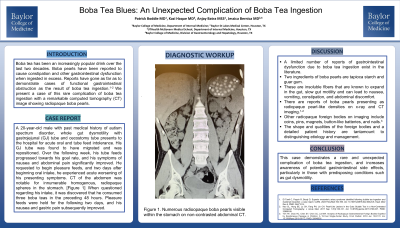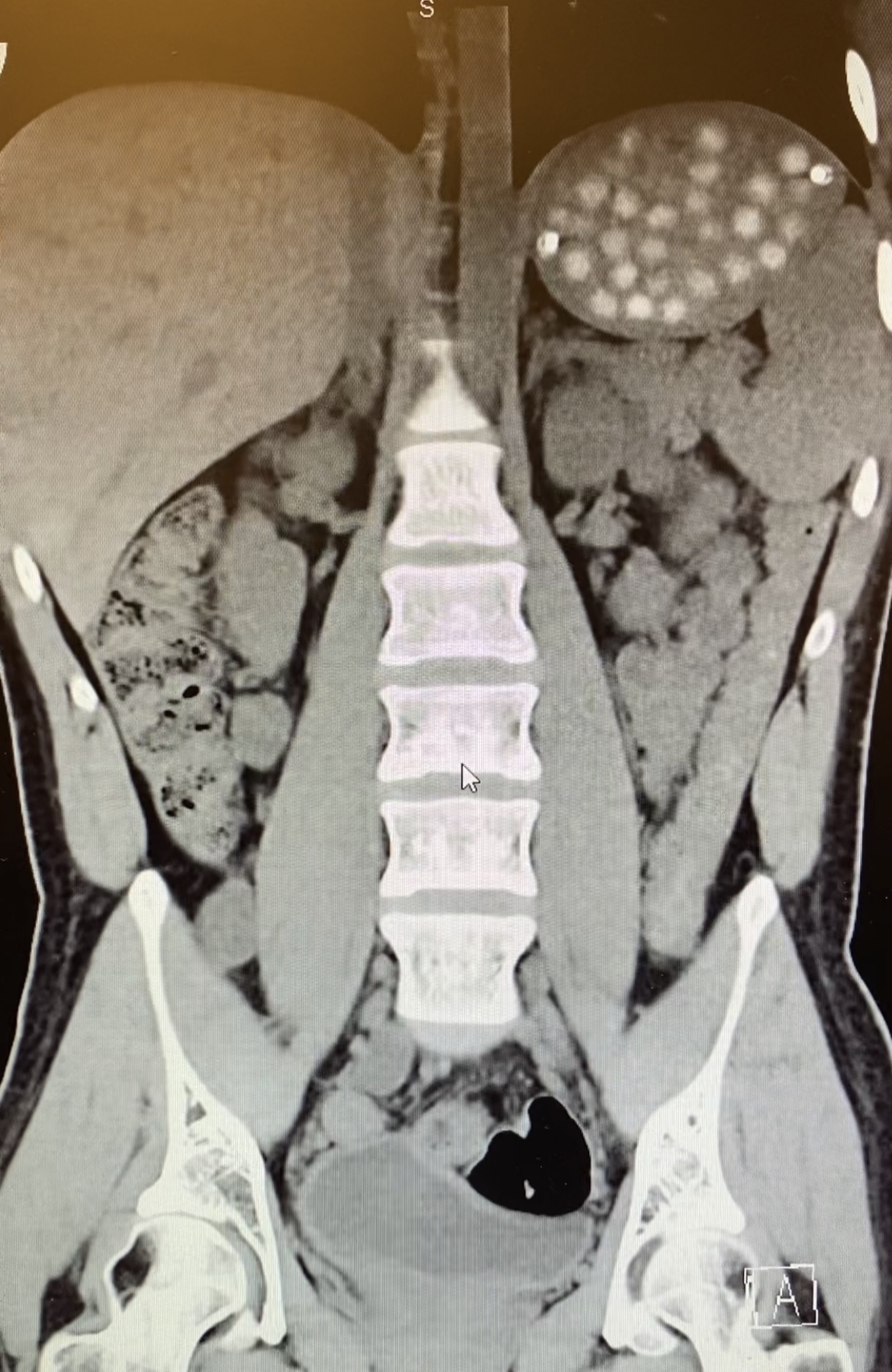Tuesday Poster Session
Category: Stomach
P5131 - Boba Tea Blues: An Unexpected Complication of Boba Tea Ingestion
Tuesday, October 29, 2024
10:30 AM - 4:00 PM ET
Location: Exhibit Hall E

Has Audio
- PB
Patrick Boddie, MD
Baylor College of Medicine
Houston, TX
Presenting Author(s)
Patrick Boddie, MD1, Kazi T. Haque, MD2, Anjay Batra, 1, Jessica Bernica, MD1
1Baylor College of Medicine, Houston, TX; 2University of Texas Health, McGovern Medical School, Pearland, TX
Introduction: Boba tea (or bubble tea) has been an increasingly popular drink over the last two decades. Boba pearls have been reported to cause constipation and other gastrointestinal dysfunction when ingested in excess. Reports have gone as far as to demonstrate cases of functional gastrointestinal obstruction as the result of boba tea ingestion. Herein we present a case of this rare complication of boba tea ingestion with a remarkable computed tomography (CT) image showing radiopaque boba pearls.
Case Description/Methods: A 20-year-old male with past medical history of autism spectrum disorder, whole gut dysmotility with gastrojejunal (GJ) tube and cecostomy tube presents to the hospital for acute oral and tube feed intolerance. His GJ tube was found to have migrated and was repositioned. Over the following week, his tube feeds progressed towards his goal rate, and his symptoms of nausea and abdominal pain significantly improved. He requested to begin pleasure feeds, and two days after beginning oral intake, he experienced acute worsening of his presenting symptoms. CT of the abdomen was notable for innumerable homogenous, radiopaque spheres in the stomach [Figure 1]. When questioned regarding his intake, it was discovered that he consumed three boba teas in the preceding 48 hours. Pleasure feeds were held for the following two days, and his nausea and gastric pain subsequently improved.
Discussion: A limited number of reports of gastrointestinal dysfunction due to boba tea ingestion exist in the literature. Two primary ingredients of boba pearls are tapioca starch, an indigestible starch that provides a soft and pleasant texture, and guar gum, a substance used to stabilize the structure of the pearls. These ingredients are insoluble fibers that are known to expand in the gut, slow gut motility and can lead to nausea, vomiting, constipation, and abdominal discomfort. Furthermore, there are reports of boba tea presenting as radiopaque pearl-like densities on x-ray and CT imaging. When encountered, this finding should alert physicians to consider boba pearls as a possible etiology. Other radiopaque foreign bodies on imaging include coins, pins, magnets, button-like batteries, and nails. The shape and qualities of the foreign bodies and a detailed patient history are tantamount to distinguishing etiology and management. This case increases awareness of the potential gastrointestinal side effects of boba tea ingestion, particularly in those with predisposing conditions such as gut dysmotility.

Disclosures:
Patrick Boddie, MD1, Kazi T. Haque, MD2, Anjay Batra, 1, Jessica Bernica, MD1. P5131 - Boba Tea Blues: An Unexpected Complication of Boba Tea Ingestion, ACG 2024 Annual Scientific Meeting Abstracts. Philadelphia, PA: American College of Gastroenterology.
1Baylor College of Medicine, Houston, TX; 2University of Texas Health, McGovern Medical School, Pearland, TX
Introduction: Boba tea (or bubble tea) has been an increasingly popular drink over the last two decades. Boba pearls have been reported to cause constipation and other gastrointestinal dysfunction when ingested in excess. Reports have gone as far as to demonstrate cases of functional gastrointestinal obstruction as the result of boba tea ingestion. Herein we present a case of this rare complication of boba tea ingestion with a remarkable computed tomography (CT) image showing radiopaque boba pearls.
Case Description/Methods: A 20-year-old male with past medical history of autism spectrum disorder, whole gut dysmotility with gastrojejunal (GJ) tube and cecostomy tube presents to the hospital for acute oral and tube feed intolerance. His GJ tube was found to have migrated and was repositioned. Over the following week, his tube feeds progressed towards his goal rate, and his symptoms of nausea and abdominal pain significantly improved. He requested to begin pleasure feeds, and two days after beginning oral intake, he experienced acute worsening of his presenting symptoms. CT of the abdomen was notable for innumerable homogenous, radiopaque spheres in the stomach [Figure 1]. When questioned regarding his intake, it was discovered that he consumed three boba teas in the preceding 48 hours. Pleasure feeds were held for the following two days, and his nausea and gastric pain subsequently improved.
Discussion: A limited number of reports of gastrointestinal dysfunction due to boba tea ingestion exist in the literature. Two primary ingredients of boba pearls are tapioca starch, an indigestible starch that provides a soft and pleasant texture, and guar gum, a substance used to stabilize the structure of the pearls. These ingredients are insoluble fibers that are known to expand in the gut, slow gut motility and can lead to nausea, vomiting, constipation, and abdominal discomfort. Furthermore, there are reports of boba tea presenting as radiopaque pearl-like densities on x-ray and CT imaging. When encountered, this finding should alert physicians to consider boba pearls as a possible etiology. Other radiopaque foreign bodies on imaging include coins, pins, magnets, button-like batteries, and nails. The shape and qualities of the foreign bodies and a detailed patient history are tantamount to distinguishing etiology and management. This case increases awareness of the potential gastrointestinal side effects of boba tea ingestion, particularly in those with predisposing conditions such as gut dysmotility.

Figure: [Figure 1] Numerous radiopaque boba pearls visible within the stomach on non-contrasted abdominal CT.
Disclosures:
Patrick Boddie indicated no relevant financial relationships.
Kazi Haque indicated no relevant financial relationships.
Anjay Batra indicated no relevant financial relationships.
Jessica Bernica indicated no relevant financial relationships.
Patrick Boddie, MD1, Kazi T. Haque, MD2, Anjay Batra, 1, Jessica Bernica, MD1. P5131 - Boba Tea Blues: An Unexpected Complication of Boba Tea Ingestion, ACG 2024 Annual Scientific Meeting Abstracts. Philadelphia, PA: American College of Gastroenterology.
